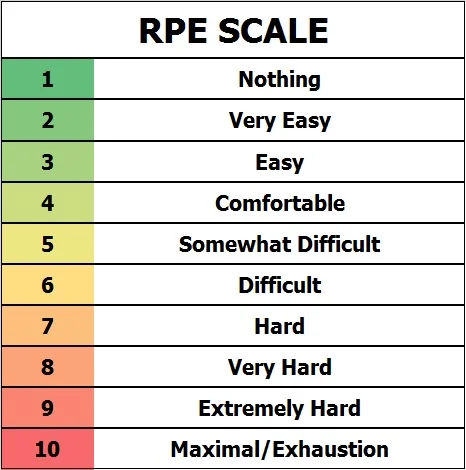Training Intensities, and How to Manage Them
October 7, 2022
Training is a stressor. Too much of it, and you’ll burn out… too little of it, and you haven’t done enough to create a stimulus. In order to make progress in any given physical activity or sport, the body must be challenged appropriately. Knowing when to pull back, and when to push harder is a learned skill.

A well balanced training program includes various intensities, using peaks and valleys to elicit change, but also allowing time for the body to recover. It’s not necessary to train to failure (or max effort) in order to provide a sufficient stimulus. For example, if your goal is to increase your max deadlift, then it would be best to train more regularly at 70-85% of your max lift. The same thing applies for running; little progress will be made if you only train at max speed or effort.
This concept may be intuitive for a coach or an advanced athlete, but what if you are just starting out, or just learning to program for yourself? An easy entry point into understanding training intensities is through the use of the RPE Scale.
10 Point RPE Scale
The Rate of Perceived Exertion (or RPE) is a way to measure the level of exertion that a person feels during physical activity. The scale runs from 1-10, and can be applied to a given exercise, or a full workout. In an RPE scale, the harder the effort, the higher the number. A value of 1 is associated with low intensity (think sitting or walking), while a 10 is high intensity (like a 400 lb. deadlift).
As coaches or practitioners, we tend to use a 1-10 scale as a way to communicate with our clients. After a given set, we may ask a client, “On a scale from 1-10, how hard was that for you?” If the client responds with, “3” then we may suggest that they work at a higher threshold on the next set. An increase in weight, or reps can quickly increase the intensity. A common question we get is, "What if my idea of a 3 is different than someone elses? How can you really know exactly how I am feeling?" The answer to this is: We are comparing the numbers you give us today to the numbers you gave us yesterday, and the numbers you gave us when you started. We are evaluating and analyzing you against yourself, not against others.
There are other situations in which a number scale may be useful. It can be used to gauge your energy levels before you jump into a workout. If someone has had little sleep and feels run down, then their body is already operating at a higher level of stress. It would be wise to train at a lower threshold than normal (maybe a 4-5 on the scale). Even in a time of advanced technology and statistics (read: wearables on all our wrists), a simple scale rating is still one of the more effective and honest ways to communicate with your own body.

RPE as a Running Metric
How can you integrate RPE into your current training? Let's revisit the theory behind designing a smart training plan. You should have a balance of high intensity, and low intensity days. If you push hard one day, then the next day should be of a lower intensity.
Let’s use running as an example; you are a busy professional who only has time for 3 runs a week. How can we manipulate the intensity of each run? See the breakdown below:
Negative Split:
The focus of this run is to finish faster than you first started. Run your first mile at 4 RPE, and increase the intensity each mile thereafter. That last mile should be closer to a 7 or 8 RPE.
Recovery Run:
This run has a consistent RPE of 3-5 the whole time. Operate at low intensity for time or distance.
Tempo Run:
Treat this run as intervals. Sprint at 9-10 RPE, followed by long rest periods of 1-2 RPE.
If you've ever downloaded free marathon training plans online or worked with a run coach, you've probably noticed that you never have your speed/tempo workouts stacked back to back with your long runs. You also never have long runs on adjacent days. This is in line with the idea of balancing your high RPE days with your low RPE days, so your body has a chance to recover and prepare for each workout appropriately.
Pro tip: Compare these numbers to the types of heart rate or threshold zone training that you may also encounter in training plans. How are they similar or different? Try pacing your runs by "feel," aka RPE, rather than by checking your watch the entire time.
Using RPE to manage Strength Training
One last thing to note with RPE is how it may change during your off-season. If your main sport is running, then you likely have a season of races (usually in fall or spring). When in-season, the RPE of your given workouts will tend be lower, like a 5-7. This is just to keep the body feeling fresh for race day. During the off-season however, you can afford to increase the RPE of your strength workouts. The body can handle higher intensities and stress levels being that there are no upcoming races. Manipulating your RPE can be done through:
-
How heavy of a weight you are using
-
How many sets or reps you perform
-
How elevated your heart rate gets
Make sure to take your race timeline into consideration when managing your strength training. If you're not sure what that should look like, consult a strength coach or a physical therapy for more concrete planning!

MICHAEL AUTORE
Having played football from his youth through college, Michael has spent years in the gym as an athlete and coach. He was first introduced to weightlifting as an early teen, and has worked with many styles of training since. Michael holds experience in various roles in coaching, management, sales, and membership. He joined the MOTIVNY team in 2019, and is available for one-on-one training (both virtual and in-person), as well as Kinstretch and Kettlebell classes. When teaching or coaching, you can find Michael dancing around to one of his playlists or cracking jokes. He creates a fun, yet challenging environment and invites others to join along. Certifications include FRCms, FRA, Kinstretch, and SFG2.
michael@motivny.com